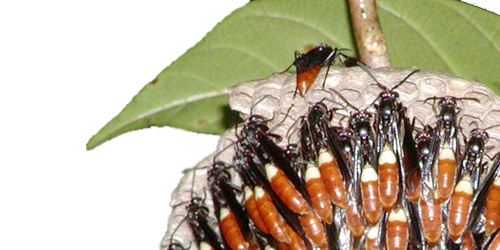I study wasps. That’s what I do.
Solitary wasps, like most animals, live their life . . . well, in solitude. Except to mate, they tend to stay away from other members of their own species. Some build small nests for their young, and some provide a modicum of parental care—the first steps toward social habit—but they do not live together in groups.
Social wasp colonies come in a variety of flavors. Some are composed of tentatively co-existing individuals, and little cooperation happens, except to share a nest. Some social wasps join together to make a group, and they fight to see who gets to be the queen. The one that wins gets to lay eggs, subjugates the others, and the others often try relentlessly to overthrow her rule; they want to lay eggs too, and they have the ovaries to do so, but they often just settle for being a worker, a forager, a builder—and if they lay an egg or two, it’s surreptitiously. I think it’s easy to see that this is a rather unstable social group, and even in these groups there are cycles of social behavior interrupted with solitary behavior. Both social and solitary interests are obvious.
Other social wasps are more interconnected. Some wasps in Central and South America (including Apoica) form large colonies of individuals who cooperate extremely well. In this derived situation, the worker wasps are much more numerous, and they now run the show—they subjugate the queens, often kicking potential or undesirable queens out of the nest. And the workers are workers, forever. They can’t lay eggs. (They just don’t have developed ovaries; there are exceptions of course, but in general, they don’t.) Only the queens have the properly developed organs needed to lay eggs. Here, we see the first permanent and most fundamental subdivision of labor necessary for stable social habit: The division of labor between the reproductives and the sterile workers.
The workers often come in different shapes and sizes; the queen differs from them. These differently equipped sterile workers work—they defend the nest; they forage for food, water and wood, which they macerate into pulp for the nest; they repair damage; they build new parts; they feed the young; and they dispose of the dead. The queen does none of these. Well, in some instances she may initiate the paper cells into which she lays the eggs, but other than that, she lays eggs and does little more.
None of these wasps are ever alone; when the colony gets too big, a group of queens and a group of workers, and rarely a small cohort of males (the workers are all female) fly to a new site and begin a new nest. The solitary life has been completely abandoned; the division of labor has made sure of that. These wasps are almost certainly locked, or approaching being locked, into sociality. The queen doesn’t forage and the workers all work. They have specialized so much that reversal to the solitary habit would be difficult . . . but it does happen.
Rogue wasps defy the structure and reverse in their behavior to the ancestral, the solitary. They eat food, take resources, enjoy protection, and contribute nothing. Sometimes they are outright aggressive (recall, solitary wasps don’t like to be around others). They lay eggs (against the rules), and their offspring may inherit their tendencies. They are commonly called “cheaters,” because they don’t keep the social compact. They often lose in their mission that if unchecked could disrupt the entire social system. They are ejected, or killed by other workers. But sometimes, their rogue efforts go unchecked, and the entire colony then can be at risk of collapse. Because they shrug off their roll as worker (no doubt due to a random mutation), and reject the division of labor upon which the colony is based, the entire system can fail.
Other wasps have taken these divisions of labor even further. In some hornets, for example, preliminary evidence suggests that the larvae of the nests, the young, are the only individuals who can digest food. The adults feed the larvae, and the larvae feed back to the adults digested vomit and spit. If the adults are separated from the larvae, they die of starvation.
This work, ongoing in my lab, is preliminary, as I said, but intriguing if true. This would mean that the genes to digest food (which they all have) have been silenced in the adults, and only the workers express those genes and have those proteins and enzymes. The larvae have become workers of a new and specialized type. They have become the digesters of the colony. They have become the stomach. Division of labor has arrived at a new, extreme level: the development of tissues, organs.
So why am I writing about all of this? Partly, of course, because this is the stuff I think about all the time: wasps, and the transition for solitary to social. But I see clear connections to our bodies, and to cancer. My view is not novel, to be sure, but for me it is comforting, in a way.
Each of us is a giant colony of intimately cooperating individual cells. They all descend from a single cell. At the first division, they could separate and go their own way, like bacteria do all the time. But they don’t, at least not usually. Sometimes this is exactly what happens. A very good friend of mine was in the early stages of pregnancy years ago, before I knew her. It isn’t clear exactly what happened, but something like this is plausible: At some point during the early stages, an unfertilized egg, or the embryo’s cells, or some cell incurred a random mutation. The mutation caused the cell to revert to its ancestral, primitive instincts. That one cell shrugged off the social contract and started dividing without control. The cells would divide and go their own way, just like their ancestral bacterial brethren, with no cooperative instinct remaining. In other words, one of the embryonic cells became a “cheater” in the social contract. It didn’t play its roll, take its position as a worker, or as they are commonly called, a differentiated cell type. The cheater had the potential to destroy the entire colony, my friend. In wasps, these mutants are called “cheaters.” When it happens in us, we call it cancer. (My friend has been cancer-free for years, thanks to chemotherapy.)
But usually, the cells all stay in line. They don’t divide and go their own way; they divide, and stay, and differentiate into tissues—various subcastes of the worker caste. Once we’re born, these cells do various things: they defend the body; they distribute food; they repair damage; they build new parts; and they dispose with the dead. The sex cells do none of these. Sound familiar?
For my cancer, the correspondence is crystal clear. In my case, the particular mutation that occurred was demonstrated genetically. In my case two of my chromosomes in a single cell physically crossed over on another. And when the crossing over occurred, the top part of one chromosome was attached to the bottom of the other, and vice versa. This is a common enough occurrence, especially for germ, or sex cells (you know, our queen caste). But in this case, when this happened, a particular gene, named bcl-2, was placed in contact with a so-called hyper-promoterenhancer‡—a region of DNA that controls the expression, the copy rate, of a gene. Bcl-2 makes a protein, and placed next to this hyper-promoterenhancer, it started making a lot of this protein.
This particular protein—from an ancient gene that we share with nearly all cellular life—in multi-cellular organisms controls a phenomenon seen in their cells called apoptosis, programmed cell death. Programmed cell death is a fundamental part of the social contract of our bodies, our apoikas of individual cells. In such a group environment, cells can’t divide without end, and they can’t stay forever. Cells must die sometimes, and make way for other cells, else the group of cells—our bodies—may have problems.
And here was the crux of my problem. The more bcl-2 that is expressed, the more easily a cell can resist signals to kill itself. So in me, when bcl-2 started being hyper-expressed in that one cell, it became immortal. And with that, the social contract was broken, and the cell started off on its own way, dividing and giving to all its daughter cells the same tendencies. As this social cheater continued to pursue its selfish interest, the whole colony—my body—started having problems. And I got sick, as those immortal daughters became so numerous that they began to clog up passageways, organs, and vessels.
This is the natural history of my cancer, follicular b-cell lymphoma, the best example that proves cancer cells are nothing more than cheater wasps at the nest. From their perspective (that is, from a selection standpoint), being freed from programmed cell death ain’t a bad thing at all. Individuals that leave more offspring win, right? This cell was on Logan’s Run . . . and having lots of babies at the same time. The problem is, all those cells that are (were?) in my body don’t have global knowledge, and so they don’t realize that they are sealing their own fate: If the colony dies, so do they, in this case. There is no complete reversal to the free-living single cell. We’ve evolved too far for that. Or have we . . . (more on that later).
This is my view. I just wanted to share it. I am comforted by it, because I understand the how and the why of my cancer. I have never once asked “Why is God doing this to me?” That’s just never been in my head. I know why I have cancer, and I understand that the cancer cells in my body—once freed from the social contract—are just like bacterial invaders. They are trying to make their way, and reproduce, like all other creatures. It’s simply an unavoidable consequence of nature.
‡UPDATE: The distinction between a promoter and an enhancer is subtle, and I won’t go into it here. But I needed to correct it, because in an attempt to write generally, what I wrote was technically incorrect.

























